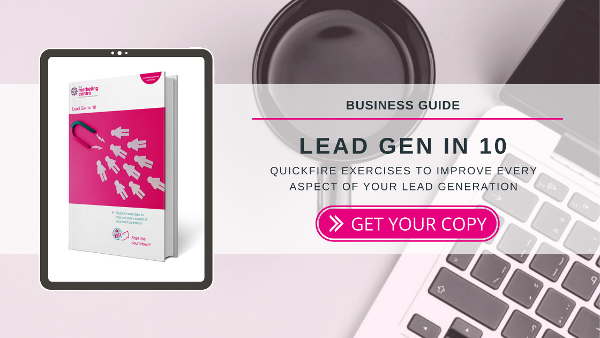Our Lead Generation Clinic gave you the chance to have your most pressing lead generation questions answered by our team. If you missed out, don’t worry - you can watch the clinic in full here.
Here are the top 10 questions we were asked, along with our answers.
Planning
1. How do I decide who to target?
Robert Stead recommends starting by defining your ideal customer. “Have a look at your existing customer base”, he says. “Understand which of those are the ones you really want to keep and want more of.”
Understand how these customers fit your offering and revenue profiles, and find the commonalities between them. From there, you can define your target company, and look at who within those companies might be making the buying decision.
Drill down to establish what those people’s drivers and pain points are - the reasons they want things to change. This will inform your value proposition and messaging.
Using data from the ONS and data vendors, you can then understand how many of these people exist and who they are.
“I also encourage people to be as clear, precise and focused as they possibly can”, says Robert. “A few good targets will always outperform a lot of very poor targets in terms of both marketing efficiency and sales success”.
2. How can we get more leads?
This was one of the most common questions asked by those who pre-registered for our webinar.
Pete Jakob explains that many businesses use a combination of both inbound and outbound tactics. While inbound marketing is centred around creating content that draws potential customers to your brand, outbound marketing requires that you’re more proactive: actively reaching out to prospects to encourage them to purchase.
“With an inbound approach, you create content that is relevant for your audiences and addresses those pain points”, he says. For many businesses, it’s a perfect strategy: you’re engaging with prospects who are looking for a solution that you’re providing.
But this can take time. With outbound lead generation, you’re trying to identify targets who may have the issue you know you can solve. “You’re trying to reach them in the hope that they’ll engage”, says Pete. “It’s quicker to deliver into the market, although it inevitably means more wastage - tight targeting and good data are key, along with messaging that will resonate with your target audience.”
5 quickfire exercises to improve every aspect of your lead generation
Everything you need to know to generate more leads.
Get our Lead Gen in 10 workbook today.
3. What do I need to know about buying data?
“Not all data providers are the same”, says Pete. “They all have their own strengths and weaknesses.”
Take into consideration a vendor’s geographic coverage and whether that’s aligned with your targets. Try to check sample data if you can. Check their GDPR compliance to make sure they’re doing things by the book - and be clear in your own Privacy Statement about how you’re processing that data.
“Beware of cheap lists too”, says Pete. “Often, they’re old subscription lists from magazines or scraped from other secondary sources."
His final piece of advice is to check the terms of the data that’s being offered - he generally sees three different offer types:
- 12-month licence: You’ll rent the data for a 12-month period, and need to promise not to use the data after that time
- Perpetual licence: This sounds great but be aware, this data will decay over time. Sometimes by as much as 25% per year.
- Perpetual and updated: This is accessed via a live portal - and may well be more expensive, but there will likely be less wastage over the long-term.
4. What is a “good lead”?
“There’s a big problem with the phrase ‘good lead’”, says Robert. “If a lead comes to nothing, sales blame marketing for giving them a duff lead, while marketing blame sales for not working hard enough to close it.”
This is where defining a lead as an MQL (marketing qualified lead) or SQL (sales qualified lead) can make a difference. “The reality is, anyone who buys from you goes through a process from having never heard of you to becoming a committed customer”, says Robert.
In doing so, they go through different stages. Your job is to decide and define at which stages marketing should engage with them, and when it’s more appropriate for the sales team to be involved.
For more on lead definition - including MQLs and SQLs - see here.
5. How many leads do I need?
Pete stresses that there are two things to consider before you answer this question.
“The first is you shouldn’t assume that all your revenue necessarily needs to come from lead generation”, he says. Think about other sources: existing clients, customer referrals, increased prices and switching your distribution channels.
These are some of the seven marketing levers of growth, which you can learn more about in our on-demand webinar here.
To determine how many leads you need to hit your revenue targets, all you need is your financial targets for the coming year, and your sales data for the previous year. This exercise (and the spreadsheet linked on this page) will allow you to work out that magic number.
Lead creation
6. Which tactics should we use?
“This is a completely impossible question to answer off the cuff”, says Robert. “You need to understand the environment and what a business is looking to achieve first.”
Marketing - and lead generation - is a process. There is never just one magic tactic: instead, it’s about mapping your touchpoints to find out what’s working well and what needs improvement.
The Marketing Centre conducts an annual lead generation survey, the latest data from which reveals that email and LinkedIn are currently the most popular lead gen tactics.
That’s not to say that these will work for every business, though. Just because a tactic is popular doesn’t mean it’s right for you. The important thing is to think of what you’re doing in the context of a campaign rather than as an isolated tactic, and to keep testing and measuring.
Lead development
7. We have lots of leads, but nothing is happening. Why?
“Any process takes time”, says Robert. “You need to allow time for things to progress.”
If there’s no movement at all, take a look at who your contacts are (and whether they’re the right ones), and who in your business is responsible for doing what’s needed to move them to the next stage of being a qualified lead.
Once qualified, some will turn straight into an SQL and need a conversation with sales, but others won’t. “Keep working with them to develop them and engage further interest”, says Robert.
A large part of this is having a good CRM in place - and using it - to understand where things currently stand, and what the next step may be. Use your CRM to:
- Capture every single engagement with a prospect
- Understand how long it takes to move between different stages of your sales process and how that could be sped up
- Help the sales team become more productive and effective.
8. What do I do with leads that don’t advance?
“It’s just a sad fact of life that, even with great campaigns, only a small percentage of your prospects will be ready to buy right now”, says Pete. “But this doesn’t mean they won’t ever buy.”
Pete recommends a “no lead left behind” approach to lead follow-up. He suggests, on a flipchart, walking through the process that a lead goes through and what happens at each stage.
“I have never done this exercise and failed to identify some significant leakage in the sales and marketing funnel”, adds Pete. The majority of these leakages are generally pretty easy to fix - the hard part is finding them. Mapping out your complete journey - from initial response to sale - will help you identify where leads are being allowed to escape.
Nurturing programs can plug these leaks. Tactics like newsletters or programs to re-engage stalled leads can make a real difference. These can be manual or automated - but if the latter, keep monitoring their performance and looking for opportunities to optimise them.
Pete also advises thinking carefully about your messaging. “Don’t try to sell too hard”, he says. “Instead, build out content that will add genuine value to potential clients - and build in calls to action to make it easy for them to signal interest.”
Measuring success
9. How do I know it’s working?
There are two key ways to establish whether what you’re doing is working.
The first are your commercial measures. These are the things a business leader will want to focus on. These may include:
- Measuring your cost per acquisition (CPA) so you can tell how much it's costing you to win a new customer
- Measuring customer lifetime value (CLV) so you can see how much the average customer spends with you over the long-term
- Measuring churn rate so you can tell how much customers you typically lose over a given period
- Measuring customer retention cost (CRC) so you can see how much it's costing you to retain customers
- Measuring return on marketing investment (ROMI) so you can see the revenue impact of your marketing
- Measuring marketing expense as a % of revenue so you can sense check how much you're spending on marketing
The second set of measures you can use are more tactical. These help you understand how effectively you're building a pipeline of opportunities that are turning into revenue. We’ve shared some tips on setting goals for the top, middle and bottom of your customer journey funnel here.
Both sets of metrics are yet more proof that you need a good CRM in place - and that you need to use it in the right way. Building a dashboard is one thing, but you also need to look at it regularly. Pete gets his team together once a month to really drill down into performance - “it always inspires some new experiments to try to improve results”, he says.
10. Where can I learn more about lead generation?
You can watch the full webinar here, where you’ll find these questions - and more - answered in greater detail.
Or, if you’d rather read than watch, take a look at our B2B lead generation guide for our tips on generating, nurturing and making the most of your leads.






